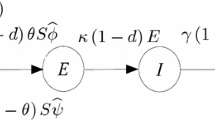Abstract
An infectious disease may reduce or even stop the exponential growth of a population. We consider two very simple models for microparasitic and macroparasitic diseases, respectively, and study how the effect depends on a contact parameter K. The results are presented as bifurcation diagrams involving several threshold values of к. The precise form of the bifurcation diagram depends critically on a second parameter ζ, measuring the influence of the disease on the fertility of the hosts. A striking outcome of the analysis is that for certain ranges of parameter values bistable behaviour occurs: either the population grows exponentially or it oscillates periodically with large amplitude.
Similar content being viewed by others
References
Anderson, R. M., May, R. M.: Regulation and stability of host-parasite population interactions. I. Regulatory processes, J. Anim. Ecol. 47, 219–247 (1978)
Anderson, R. M., May, R. M.: Population biology of infectious diseases: Part I. Nature 280, 361–367 (1979)
Andreasen, V.: Disease regulation of age-structured host populations. Theor. Pop. Biol. 36, 214–239 (1989)
Blythe, S. P., Castillo-Chavez C.: Like-with-like preference and sexual mixing models, Math. Biosci. 96, 221–238 (1989)
Busenberg, S., Van den Driesche P.: Analysis of a disease transmission model in a population with varying size J. Math. Biol. 28, 257–270 (1990)
Dietz, K.: Overall population patterns in the transmission cycle of infectious disease agents. In: Anderson, R. M., May R. M. (eds.) Population Biology of Infectious Diseases. (Report of Dahlem Workshop, pp. 87–102) Berlin Heidelberg New York: Springer 1982
Dietz, K., Hadeler, K. P.: Epidemiological models for sexually transmitted diseases. J. Math. Biol. 26, 1–25 (1988)
Hadeler, K. P., Dietz, K.: Nonlinear hyperbolic partial differential equations for the dynamics of parasite populations. Comput. Math. Appl. 9, 415–430 (1983)
Hadeler, K. P., Dietz, K.: Population dynamics of killing parasites which reproduce in the host. J. Math. Biol. 21, 45–65 (1984)
Hethcote, H. W., Stech, H. W., Van den Driesche, P.: Periodicity and stability in epidemic models: A survey. In: S. N. Busenberg, K. I. Cooke (eds.) Differential equations and applications in ecology, epidemics, and population problems, pp. 65–82. New York: Academic Press 1981
Hethcote, H. W., Stech H. W., Van den Driesche, P.: Nonlinear oscillations in epidemic models. SIAM J. Appl. Math. 40, 1–9 (1981)
Jin Cheng-Fu: personal communication
Kretzschmar, M.: Persistent solutions in a model for parasitic diseases. J. Math. Biol. 27, 549–573 (1989)
Kuang Y., Freedman, H. I.: Uniqueness of limit cycles in Gause-type models of predator-prey systems. Math. Biosci. 88, 67–84 (1988)
May, R. M.: personal communication
May, R. M., Anderson, R. M.: Regulation and stability of host-parasite population interactions. II. Destabilizing processes. J. Anim. Ecol. 47, 249–267 (1978)
May, R. M., Anderson, R. M.: Population biology of infectious diseases: Part II. Nature 280, 455–461 (1979)
Waldstätter, R.: Pair formation in sexually transmitted diseases. In: C. Castillo-Chavez (ed.) Mathematical and statistical approaches to AIDS epidemiology. (Lect. Notes Biomath., vol. 83) Berlin Heidelberg New York: Springer 1989
Ye, Yan-Qian: Theory of limit cycles. Translation of Mathematical Monographs, Vol. 66. AMS, Providence, R.I., 1986
Busenberg, S., Cooke, K. L., Thieme, H. R.: Demographic change and persistence of HIV/AIDS in a heterogeneous population. SIAM J. Appl. Math. (to appear)
Author information
Authors and Affiliations
Additional information
The work of this author was supported by a grant of the Deutsche Forschungsgemeinschaft (DFG)
Rights and permissions
About this article
Cite this article
Diekmann, O., Kretzschmar, M. Patterns in the effects of infectious diseases on population growth. J. Math. Biol. 29, 539–570 (1991). https://doi.org/10.1007/BF00164051
Received:
Revised:
Issue Date:
DOI: https://doi.org/10.1007/BF00164051




